Human Flower Project
Orthodox and Floral: Good Friday
In contrast with Roman Catholic and most Protestant churches, the Eastern Orthodox sects do not shun flowers on Good Friday: lemon flowers in Crete, floral biers in New Jersey, daffodils in Bulgaria, and more.
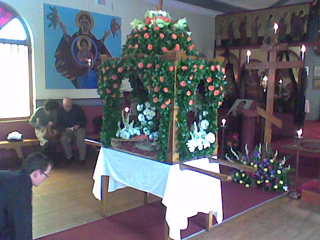
A dome-shaped Epitaphion for Good Friday,
St. Nicholas Church, Brixton, South Africa
Photo: Khanya
In the Episcopal Church, and many others, this is the most flowerless day of the year: Good Friday.
A guide to Roman Catholic sacristans for Maundy Thursday could be followed (with other names for “Mass”) by many Protestant denominations also. “Be prepared for the stripping of the altar after Mass,” writes Paul Turner. “Remove flowers, candles, altar cloth and any other decorations. This should be done quietly and reverently.”
Another liturgical handbook conveys the same message, just slightly different timing. “All decorations come down Friday morning. Cross is bare.”
Christian tradition says that Jesus was crucified at noon, and died three hours later.
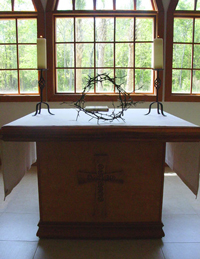 Thorns on the bare Good Friday altar
Thorns on the bare Good Friday altar
King of Peace Episcopal Church, Kingsland, Georgia
Photo: King of Peace
The Good Friday rites we have known are stridently anti-floral, poignant and harsh. In most parishes, the altar will be draped in black today. Some altar guilds drive home the absence of flowers with an empty chaplet of thorns. Rev. Matt Pennington, priest of of Santa Cruz, California’s Holy Cross Church, said that Good Friday’s rite “acknowledges the ‘cross’ everyone has” at some time in life: sickness, the loss of a loved one, a job, or a marriage.
“The church itself is really turned into a tomb,” said Pennington. “There are no flowers or comforting decorations… It really is a reflection on that experience of death, and a preparation to enter the experience of resurrection.”
Searching for images of Good Friday austerity, we found many. Then we were startled to come upon this:

Good Friday at St. Nicholas Russian Orthodox cathedral, Seattle, WA, late 1960s
Photo: St. Nicholas Cathedral
Good Friday as observed in Seattle’s St. Nicholas Russian Orthodox Cathedral, circa 1965. Who can explain the veritable thicket of gladioli?
After investigating more, we have learned that Good Friday in the Eastern Orthodox churches is a special floral occasion. The Greek Orthodox, and others, observe the Epitaphion, what appears to us to be a kind of re-eneactment of Christ’s deposition from the Cross and burial in the tomb.
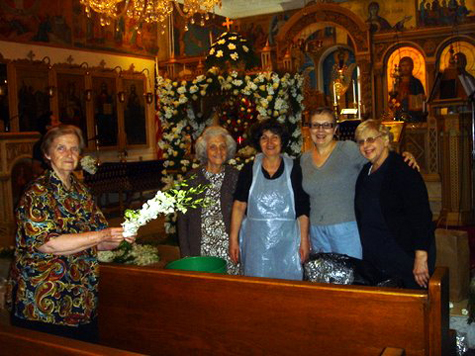
Members of St. George Greek Orthodox Church, New York City, NY
prepare the Epitaphion for Holy Friday
Photo: St. George Greek Orthodox Church
Beginning, on Maundy Thursday, church members create a funeral bier, the Epitaphion, “with garlands of flowers, so that in the morning of Good Friday it is ready to receive the image of the body of Christ when He is taken down from the Cross. Flowers of various colours are used but in Crete it is common to use the flowers of the lemon tree.”
The dome-shape of the Epitaphion, a symbol of the tomb (and reminiscent of much Orthodox church architecture, too), is sprinkled with rosewater and petals.
![]()
At Alexander Nevski cathedral, Sofia, Bulgaria, parishioners gather around the Bible and epitaphios, decorated with daffodils, at the Good Friday service 4/2/10
Photo: Getty
The Epitaphios, an image of Christ recumbant, usually embroidered on a piece of cloth, is processed through the church and laid on a Holy Table. It too is adorned with flowers.
As the ceremonial bier holding the epitaphiois is carried through the parish neighborhood, congregants strew flowers along its way and offer prayers of lamentation.
Here are several photos we’ve found of epitaphions.
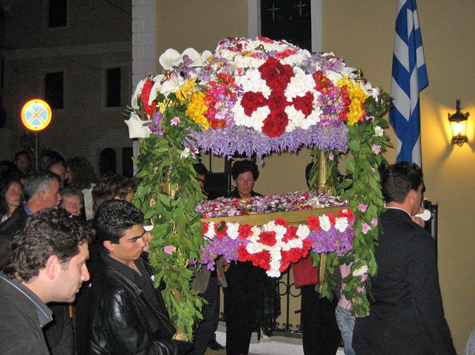
The Epitaphion: Saint Dimitri Greek-Orthodox Church, Union, New Jersey
Photo: via St. Materne
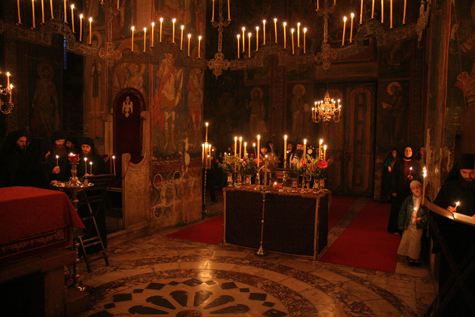
Chanting in front of the “Christ’s Tomb,” Visoki Decani Monastery, Kosovo
Photo: via Kosovo.net

Good Friday in an Orthodox church in Riga, Latvia:
“a side altar with a display of the entombment of Jesus.”
Photo: FR Coulter
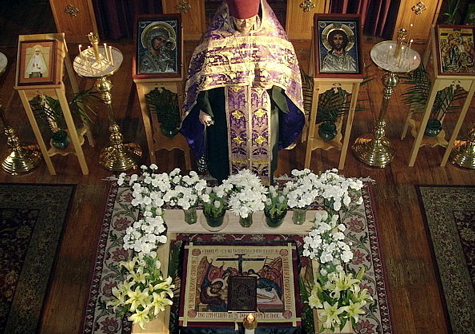
Good Friday rites, with Epitaphios, and flowers at the Russian Orthodox
Church of St. Elizabeth the New Martyr, Princeton, New Jersey
Photo: St. Elizabeth the New Martyr
When did this floral schism occur between the Western and Eastern Christians? And of greater interest, why? As always, we welcome readers to reply with information or speculation.


The lack of flowers on Good Friday is made up for at the Saturday Easter Vigil service, at least at the (Episcopalian) vigil we attended last weekend. I love the smell of Easter lilies!